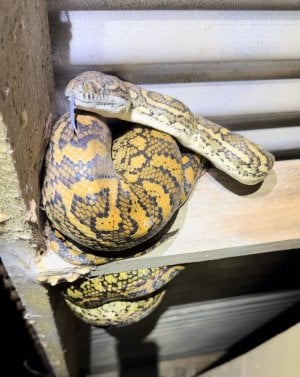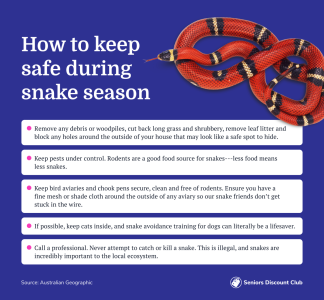Slithering into summer: Heatwave sparks early snake season alert
- Replies 25
As the mercury soars and the sun blazes down on the great Australian landscape, an unexpected consequence has emerged that could pose a significant risk to our over-60s community.
The unseasonably hot weather has sparked an early start to ‘snake season’, prompting experts to issue an urgent warning for Aussies to remain vigilant and safe around these potentially deadly creatures.
Australians are advised to stay vigilant for snakes as the rising temperatures drive the reptiles to the surface.
The heatwave, which has seen record-high temperatures for winter, has led to snakes waking from their brumation—a hibernation-like state—much earlier than usual.
This means that encounters with snakes, including the notorious brown snake, could become more common as they venture out in search of cooler environments and food.

Billy Collett, Operations Manager at the Australian Reptile Park, has highlighted the importance of understanding snake behaviour during these warmer months.
‘Typically, snakes do not come out of brumation until September. However, due to the unseasonably warm weather, experts warn that snakes could be active much earlier this year,’ he explained.
To minimise the risk of an unwelcome encounter with a snake, there are several precautions that can be taken.
‘All households to keep grass areas around their house mowed and well maintained; also avoid piling up leftover firewood or accumulating stick piles,’ Mr Collett advised.
‘Tin sheets or any household items like these that are piled up can draw in heat, providing a perfect man-made habitat for snakes. These areas provide a safe house for snakes as they sit in stealth mode, awaiting prey to feed, and if startled, they will defend through biting.’
Smaller snakes are more likely to hide among dense shrubs to stay warm during the day and retain heat throughout the night.
It's important to remember that snakes are not naturally aggressive and prefer to retreat rather than attack.
They only become a threat to humans if they feel threatened, provoked, or if an attempt is made to capture them.
‘It's important that all Australians know that snakes do not go out of their way to harm people,’ Mr Collett reassured.
He also added that people should avoid any interaction with snakes, regardless of their species.
However, with around 140 different species of snakes in Australia, of which 100 are venomous and 12 are capable of delivering a fatal bite, it's crucial to exercise caution.
The Coastal and Outback areas of the Northern Territory, Queensland, and New South Wales are especially hazardous, home to some of Australia's most venomous snakes.
Included in these are the Coastal Taipan, the second most venomous snake globally, the Eastern Brown Snake, and the Mainland Tiger Snake.
‘Snake bites mostly occur when people are trying to catch or kill the snake, so if you don't do either of those things, there's a greater chance that you'll be okay,’ Mr Collett said.
If bitten, the victim should stay 'calm and still' while emergency services are called for treatment.
Additionally, a tight bandage should be applied around the bite area and the affected limb, and all jewellery should be removed.
‘By applying the pressure-immobilisation bandage, the venom cannot easily spread through the body, slowing down the envenomation process by buying the bite victim more time to seek medical attention at the hospital,’ Mr Collett explained.
‘Depending on the species of venomous snake, a bite could destroy blood cells, cause blood clots, or excessive bleeding and destroy tissue.’
‘If not correctly treated with first aid immediately, a fatality can be as quick as 30 minutes,’ he added.

As Australians face an early and intensified snake season due to unseasonably warm weather, another pressing concern has emerged.
The surge in snake sightings is not only a risk to personal safety but also raises alarms about potential hazards in homes.
Recent reports highlight an unsettling trend: snakes seeking refuge in tight spaces, which could lead to significant electrical issues.
This connection between the increased snake activity and its impact on household safety is prompting urgent discussions on how to address both the immediate risks and long-term concerns for residents.
 Have you or someone you know ever had a close encounter with a snake? What are your tips for keeping your home safe from them? Share your experiences and tips in the comments below.
Have you or someone you know ever had a close encounter with a snake? What are your tips for keeping your home safe from them? Share your experiences and tips in the comments below.
The unseasonably hot weather has sparked an early start to ‘snake season’, prompting experts to issue an urgent warning for Aussies to remain vigilant and safe around these potentially deadly creatures.
Australians are advised to stay vigilant for snakes as the rising temperatures drive the reptiles to the surface.
The heatwave, which has seen record-high temperatures for winter, has led to snakes waking from their brumation—a hibernation-like state—much earlier than usual.
This means that encounters with snakes, including the notorious brown snake, could become more common as they venture out in search of cooler environments and food.

Australians have been warned to stay alert for snakes due to an early start to the season caused by unseasonably warm weather. Credit: Facebook / Snake Catcher Dan
Billy Collett, Operations Manager at the Australian Reptile Park, has highlighted the importance of understanding snake behaviour during these warmer months.
‘Typically, snakes do not come out of brumation until September. However, due to the unseasonably warm weather, experts warn that snakes could be active much earlier this year,’ he explained.
To minimise the risk of an unwelcome encounter with a snake, there are several precautions that can be taken.
‘All households to keep grass areas around their house mowed and well maintained; also avoid piling up leftover firewood or accumulating stick piles,’ Mr Collett advised.
‘Tin sheets or any household items like these that are piled up can draw in heat, providing a perfect man-made habitat for snakes. These areas provide a safe house for snakes as they sit in stealth mode, awaiting prey to feed, and if startled, they will defend through biting.’
Smaller snakes are more likely to hide among dense shrubs to stay warm during the day and retain heat throughout the night.
It's important to remember that snakes are not naturally aggressive and prefer to retreat rather than attack.
They only become a threat to humans if they feel threatened, provoked, or if an attempt is made to capture them.
‘It's important that all Australians know that snakes do not go out of their way to harm people,’ Mr Collett reassured.
He also added that people should avoid any interaction with snakes, regardless of their species.
However, with around 140 different species of snakes in Australia, of which 100 are venomous and 12 are capable of delivering a fatal bite, it's crucial to exercise caution.
The Coastal and Outback areas of the Northern Territory, Queensland, and New South Wales are especially hazardous, home to some of Australia's most venomous snakes.
Included in these are the Coastal Taipan, the second most venomous snake globally, the Eastern Brown Snake, and the Mainland Tiger Snake.
‘Snake bites mostly occur when people are trying to catch or kill the snake, so if you don't do either of those things, there's a greater chance that you'll be okay,’ Mr Collett said.
If bitten, the victim should stay 'calm and still' while emergency services are called for treatment.
Additionally, a tight bandage should be applied around the bite area and the affected limb, and all jewellery should be removed.
‘By applying the pressure-immobilisation bandage, the venom cannot easily spread through the body, slowing down the envenomation process by buying the bite victim more time to seek medical attention at the hospital,’ Mr Collett explained.
‘Depending on the species of venomous snake, a bite could destroy blood cells, cause blood clots, or excessive bleeding and destroy tissue.’
‘If not correctly treated with first aid immediately, a fatality can be as quick as 30 minutes,’ he added.

As Australians face an early and intensified snake season due to unseasonably warm weather, another pressing concern has emerged.
The surge in snake sightings is not only a risk to personal safety but also raises alarms about potential hazards in homes.
Recent reports highlight an unsettling trend: snakes seeking refuge in tight spaces, which could lead to significant electrical issues.
This connection between the increased snake activity and its impact on household safety is prompting urgent discussions on how to address both the immediate risks and long-term concerns for residents.
Key Takeaways
- Australians were warned to be vigilant for snakes as unseasonably warm weather leads to an earlier-than-usual start to snake season.
- Experts advised that precautionary steps should be taken to minimise encounters with snakes, such as keeping grass areas mowed and avoiding piles of debris.
- Billy Collett from the Australian Reptile Park emphasised that snakes are not naturally aggressive but recommended keeping a safe distance from all snakes and avoiding provocation.
- In case of a snake bite, it's crucial to remain calm, immobilise the affected area, apply a pressure-immobilisation bandage, remove all jewellery, and seek immediate medical attention.









